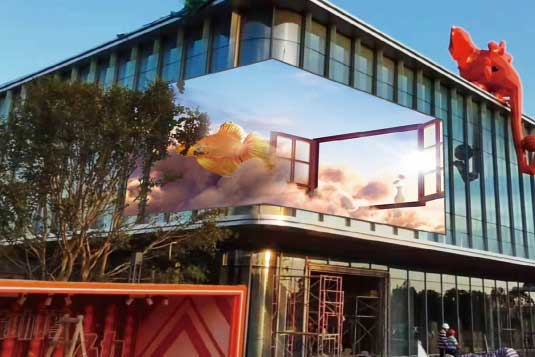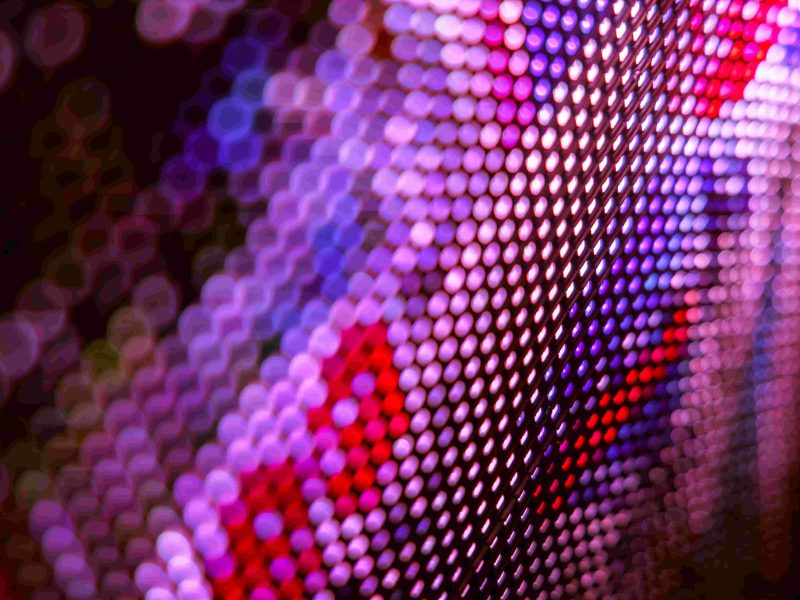Defying the Sun: Proven Solutions to Combat UV Degradation in Outdoor LED Displays
Abstract:
Ultraviolet (UV) radiation is the primary enemy of outdoor LED displays, causing yellowing, fading, cracking, and catastrophic failure. This technical deep-dive explores multi-layered defense strategies: advanced material science (glass vs. stabilized polymers), precision optical coatings (UV-cutoff + AR), thermal engineering, and rigorous IEC/ASTM testing protocols. Backed by performance data tables and degradation curves, we reveal how to achieve 50,000+ hour lifespans under direct solar assault.
The Invisible Destroyer: UV Impact Mechanisms
(描述图片位置: 光谱图显示太阳辐射中UVA/UVB波段与材料吸收峰的重叠)
Solar UV (295-400 nm) triggers photochemical reactions in polymers:
-
Chain Scission: Molecular bonds break, reducing strength -
Oxidation: Oxygen radicals cause yellowing (ΔYI > 10) -
Crystallization: Loss of flexibility leads to microcracks
Consequences:
-
Brightness Loss: Up to 40% after 3 years (unprotected PC) -
Color Shift: ΔE > 5 noticeable to human eye -
Structural Failure: Sealant cracking → moisture ingress
Material Science: The Foundation of UV Resistance
Table 1: Face Material Performance Comparison
| Material | UV Stability | Cost Index | Weight (kg/m²) | Impact Resistance | Lifetime* |
|---|---|---|---|---|---|
| Polycarbonate (PC) | Low | 1.0x | 1.2 | Excellent | 2-3 yrs |
| UV-Stabilized PC | Medium | 1.8x | 1.2 | Excellent | 5-7 yrs |
| Modified Acrylic | High | 2.2x | 1.5 | Good | 8-10 yrs |
| Chem. Tempered Glass | Very High | 3.5x | 6.8 | Fair | 12-15 yrs |
*Lifetime to ΔYI=5 under 1,200 W/m² UV irradiance
Key Innovations:
-
Co-extruded PMMA: UV-blocking layer (100μm) bonded to clear substrate -
Nano-ceramic Glass: Embedded UV absorbers with >99% cutoff at 380nm
Optical Coatings: Precision Barrier Technology
(描述图片位置: 涂层透射率曲线对比 – 普通涂层 vs. UV-cutoff+AR 涂层)
Critical Coating Parameters:
| Coating Type | UV Block (280-400nm) | Visible Trans. | Haze | Adhesion |
|-------------------|----------------------|----------------|------|----------|
| Standard AR | <20% | 98% | 0.8% | 3B |
| Hybrid UV+AR | >98% | 96.5% | 1.2% | 5B |
| Plasma CVD SiO₂ | >99.5% | 97.8% | 0.5% | 5B |
Deployment Strategy:
-
UV Cut-off Layer: Absorbs 380-400nm radiation (peak degradation) -
Anti-Reflective Stack: 4-layer MgF₂/SiO₂ reduces reflectivity to <1.5% -
Hydrophobic Topcoat: Water contact angle >110° reduces dirt retention
Thermal Management Synergy
Thermal Acceleration Model:
Degradation Rate = 2^((T_actual – 25°C)/10)
Figure: LED Junction Temp vs. L70 Lifetime
(描述图片位置: 曲线图显示结温85℃ vs. 65℃时寿命从54,000hr → 112,000hr)
Cooling Solutions:
-
Phase Change Materials: Latent heat absorption at 45-50°C -
Vapor Chamber Spreaders: Thermal resistance <0.15 K/W -
Intelligent Fans: PWM-controlled with IP68 bearings
Validation: Accelerated Testing Protocols
Table 2: IEC/ASTM Compliance Requirements
| Test Standard | Duration | Conditions | Pass Criteria |
|---|---|---|---|
| IEC 60068-2-5 | 56 days | 1120 W/m² @ 340nm | ΔYI < 3, ΔE < 2.5 |
| ASTM G154 Cycle 1 | 3000 hr | UV 340nm 0.77W/m² @60°C | No cracking/delam |
| IEC 61215 UV Test | 15 kWh/m² | 280-400nm spectrum | Pmax loss < 5% |
Real-world Correlation:
3000hr QUV testing ≈ 5 years Florida exposure
Cost-Benefit Analysis
Figure: 10-Year TCO Comparison
(描述图片位置: 柱状图对比普通屏/UV屏/玻璃屏的维护+能耗+更换成本)
| Protection Level | Initial Cost | Y5 Maintenance | Y8 Replacement | Total 10Y Cost |
|------------------|--------------|----------------|----------------|----------------|
| Basic | $100% | 45% | 120% | 265% |
| Enhanced UV | 180% | 12% | 0% | 192% |
| Glass Front | 350% | 5% | 0% | 355% |
Integrated Defense Architecture
Optimal Configuration:
[Glass Front Surface]
│
[UV-cutoff + AR Coating]
│
[Thermal Conductive Adhesive]
│
[Copper Vapor Chamber] → [PCM Heat Sink]
│
[IP68 Sealed Enclosure]
Maintenance Protocol:
-
Quarterly: Yellowness Index measurement (ASTM E313) -
Biannual: Luminance uniformity calibration -
Annual: IR thermography for hotspot detection
Conclusion: Engineering Solar Immunity
Victory over UV degradation requires material science precision, optical physics mastery, and thermal systems engineering. With premium glass fronts now achieving >98% UV rejection at only 3.2x PC cost, and predictive maintenance algorithms cutting downtime by 70%, displays surviving 15+ years in desert climates are now an engineering reality – not a promise.


-800x600.jpeg)
